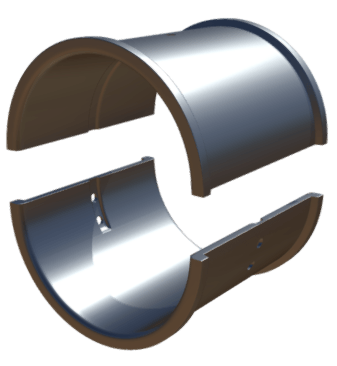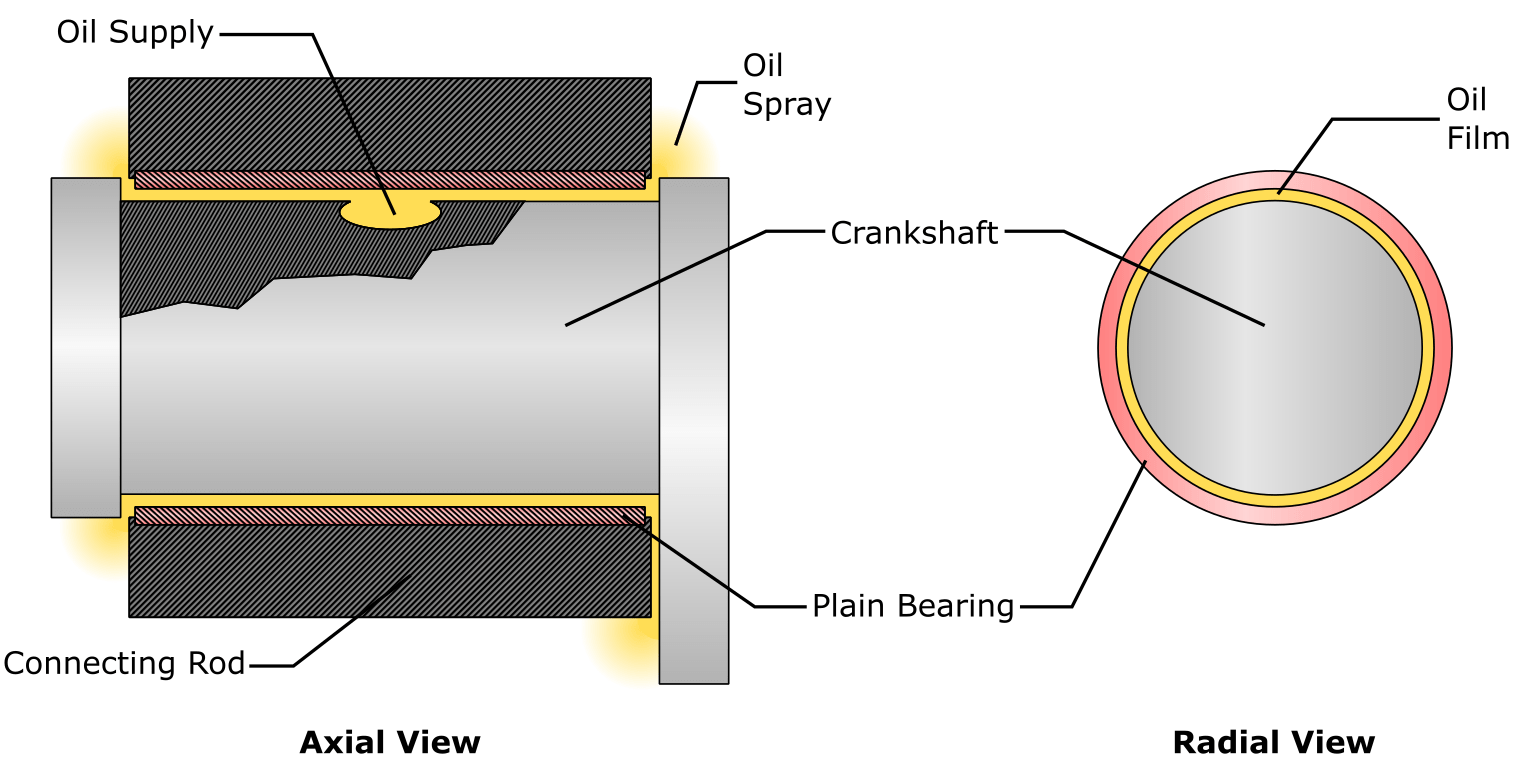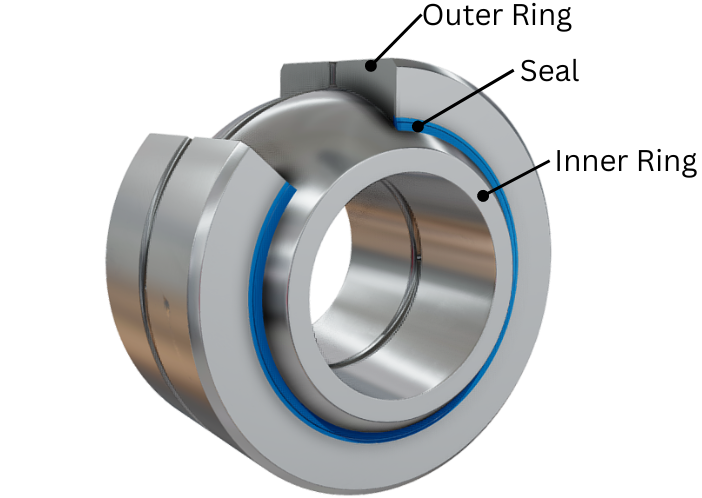Bearing Types
There are two main categories of bearing, plain and anti-friction (rolling). Plain bearings operate on the principle of sliding motion whilst rolling bearings operate on the principle of rolling motion.
Plain Bearings (Sliding Friction Bearings)
Plain bearings operate on the principle of sliding friction and employ no rolling elements; they are generally quieter than anti-friction bearings as they have no moving parts. Plain bearings may be used for rotational or linear applications. For example, a shaft rotating in a hole represents a plain bearing being used to constrain rotational motion; a sliding drawer represents a linear application. Plain bearings are generally chosen for high load, low speed applications.

Plain bearings are also called sliding bearings, thin film bearings, film bearings, journal bearings, white metal bearings, Babbitt metal bearings, hydrodynamic bearings and hydrostatic bearings. Unfortunately, these terms are not always applied correctly, which leads to confusion. For example, Babbitt metal bearings are bearings that have been manufactured from Babbitt metal (a soft metal alloy), but people often label all plain bearings ‘Babbitt bearings’, which is incorrect.
Plain metal bearings are utilised for many large machinery items, including steam turbines and large marine two stroke vessels, but they are also used for almost all internal combustion (IC) engines, as they allow the bearing to be installed in two -or more- separate pieces.
Plain Bearing Lubrication
Sliding one material across another creates friction, heat, and wear. Apart from when used for very low load applications, a plain bearing will always employ some form of lubricant to reduce friction. It is theoretically possible to use many liquids and gases as lubricants, although the most common is mineral oil. Other tried and tested lubricants include water, liquid refrigerant, kerosene, petrol, various acids and even molten metal. See our bearing lubrication article for further details.
Plain bearing lubricants separate the entire bearing surface from the load surface, thus there is theoretically no contact between the two sliding surfaces. Although there is theoretically no contact between the surfaces, in reality, it is very difficult to completely separate the two surfaces at all times.

Plain Bearing Lubrication
Most plain bearings utilise liquid lubricant. For example, almost all automobiles use some form of lubricating oil system. Oil is pumped into the space between the bearing and load surfaces (hydrostatic lubrication) and this creates a thin film of oil that completely separates -theoretically- the two sliding surfaces. Once the engine is running (four stroke or two stroke), it is possible to lubricate the engine due to the motion of the shaft (hydrodynamic lubrication).
Plain bearings should never be put into service without some form of lubrication being supplied, wear at start-up is usually more than the wear during the entire period when the engine is running.
Enjoying this article? Then be sure to check out our Bearings Video Course! The course has a quiz, handbook, and you will receive a certificate when you finish the course. Enjoy!
Fluid Bearings (Hydrostatic and Hydrodynamic)
Fluid bearings are bearings that utilise a thin layer of oil or gas to completely separate the bearing surfaces from the load. This type of bearing is used for high load and high-speed applications. Fluid bearings are classified as hydrostatic and/or hydrodynamic.
Hydrostatic bearings are lubricated using an external pump to maintain a static head of pressure. For example, a lubrication system may consist of an oil sump, pump and bearings. The system is hydrostatic because the oil pump provides the static pressure head needed for lubrication.
Hydrodynamic bearings are lubricated by the movement of the shaft itself. The moving shaft rotates and creates an oil wedge between the bearing contact surfaces.
It is possible for a bearing to be both hydrodynamic and hydrostatic lubricated. For example, an oil pump may lubricate bearings prior to the engine being started (hydrostatic lubrication), but the pump will shut down once the engine is in operation (hydrodynamic lubrication).
Sacrificial Materials
The material of plain bearings is chosen to be sacrificial compared to the journal (area on shaft where bearing sits) to which it is mounted. If two materials are rubbed together, the sacrificial material is the material that begins to wear first. Plain bearings are sacrificial because otherwise the journal would wear rather than the bearing. This is undesirable because the journal (part of a shaft) is usually more expensive and more difficult to replace than the bearing.
What is a journal bearing?
The area on a shaft that mates with a bearing is known as a journal. A journal bearing is a bearing that is mounted onto a journal, but it could also be called a plain bearing, or Babbitt metal bearing etc. (if manufactured from Babbitt metal), which would be correct also. Because many names are correct, but sometimes incorrectly applied, there is often confusion concerning plain bearing nomenclature. Journal bearings may be manufactured from a single piece (solid), or multiple pieces (split or multi-part), and they may be lubricated or non-lubricated.
Solid, Split or Multi-Part
Plain bearings may be solid, split or Multi-Part. A solid plain bearing is the simplest form of bearing, it consists of a cylinder with a hole bored through the centre axis. Split bearings are similar to solid bearings, but the bearing consists of two pieces. Multi-part bearings consist of more than two pieces. Examples of solid plain bearings include bushings and sleeves.
Examples of split plain bearings include crankshaft journal bearings.

360 or 180 Degrees of Contact
A plain bearing that has 360-degree contact with its mating journal, is called a ‘full contact bearing’, or, ‘full bearing’. A plain bearing that has 180-degree contact -or less- with its mating journal, is called a ‘partial contact bearing’. If the shaft’s diameter is larger than that of the bearing’s internal diameter, the bearing is classed as a ‘fitted journal bearing’.
Full contact bearings are used when the load varies and may act in several directions; an engine crankshaft uses full contact bearings. Partial bearings are used when the load is constant and applied in only one direction.
Plain Cylindrical Bearing
Plain cylindrical bearings are the simplest design of plain bearing. This type of bearing consists of a cylinder with a hole bored through the centre axis, it has no lubrication channels. Non-lubricated cylindrical bearings are only suitable for low load applications. Many gas lubricated bearings are cylindrical plain bearings, this includes those used for computer hard drives (the old kind that utilised a rotating magnetic disc).
The applications of plain cylindrical bearings are limited unless the design is modified. Adding some means of introducing lubricant to the bearing surfaces allows the bearing to be used at higher loads and speeds. Oil holes and oil grooves are used to distribute lubricant to the bearing’s load carrying surfaces. The most common types of lubricated cylindrical bearings are the four-axial groove bearing and elliptical groove bearing.
Plain, Split and Multi-Part Bearings
Split plain bearings are used for several reasons:
- Split bearings can be mounted on shafts that are not continuously straight.
- Split bearings can be mounted without removing the shaft.
Sleeve Bearings
Sleeve bearings are plain cylindrical bearings that have been manufactured from two separate materials. This type of bearing has a thin lining on the surface of the bearing that mates with the journal. The bearing surface that faces the journal is usually coated in a sacrificial material e.g. a soft metal, whilst the main bearing body (not in contact with the journal) is made of a different material e.g. steel.
Bushing Bearings
Bushing bearings are plain cylindrical bearings manufactured from a single piece of material. There is only one difference between a sleeve bearing and bushing bearing; sleeve bearings use a thin lining of bearing material that mates with a shaft, whilst bushing bearings are manufactured entirely from a single material. Bushings are usually thinner than sleeves and are structurally weaker.
Spherical
Spherical plain bearings are used when misalignment may make using other bearing designs difficult. The inner ring of the bearing is free to rotate within a spherical outer ring, which allows the bearing to pivot/rotate in order to match the orientation of the shaft. Other types of spherical bearing include the spherical roller bearing.

Spherical Plain Bearing
Spherical plain bearings are classed as ‘requiring maintenance’ or ‘maintenance free’.
Spherical plain maintenance free bearings use a PTFE material to separate the inner and outer rings; this type of bearing is sometimes called a ‘PTFE on metal’ bearing. PTFE self-lubricates and the bearing requires no maintenance (no lubricant must be added).
Spherical plain bearings requiring maintenance need to be lubricated periodically; this type of bearing is sometimes called a ‘metal on metal’ bearing.
Note
No component or machine is ever ‘maintenance free’. The phrase is often used for marketing purposes, but it is inaccurate. If an engineer performs any condition-based maintenance of the bearing (visual inspection, ultrasonic testing, vibration analysis, thermography), the bearing is being maintained. If the bearing is inspected and/or replaced periodically, it is part of a maintenance programme and is thus being maintained. The only occasion when an item is ‘maintenance free’ is when it is installed and operated until destruction, without any checks or maintenance occurring between installation and failure.
3D Model Components
This 3D model shows all major components associated with a typical plain metal bearing, these include:
- Upper Bearing Shell
- Oil Grooves
- Lubricating Oil Holes
- Lower Bearing Shell
- Flange
Related Online Engineering Courses
Anti-Friction Bearing Fundamentals
Additional Resources
https://en.wikipedia.org/wiki/Plain_bearing
https://clr.es/blog/en/plain-bearings
https://www.ggbearings.com/en/tribou/internet-bearings/bearings
https://www.maschinenmarkt.international/the-plain-bearing--function-types-and-applications-a-832022